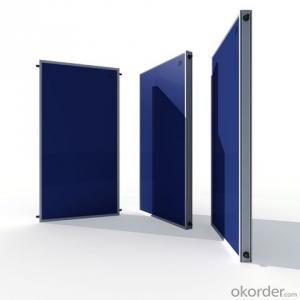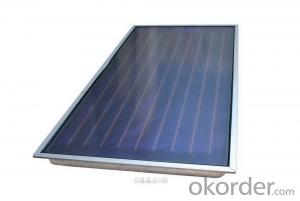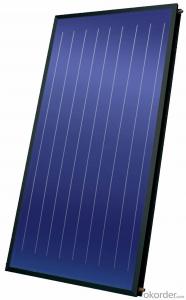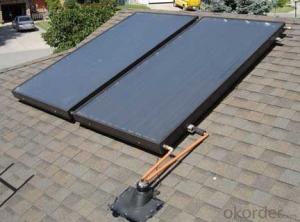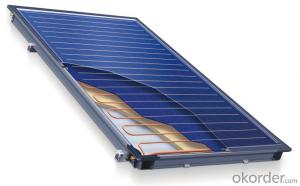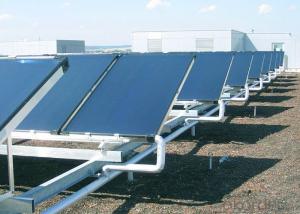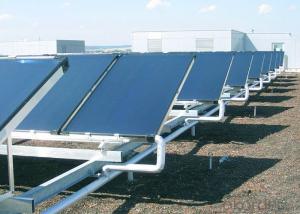Collectors
- Loading Port:
- China Main Port
- Payment Terms:
- TT or LC
- Min Order Qty:
- 1 Set set
- Supply Capability:
- 3000 Sets per Month set/month
OKorder Service Pledge
Quality Product, Order Online Tracking, Timely Delivery
OKorder Financial Service
Credit Rating, Credit Services, Credit Purchasing
You Might Also Like
Detailed Product Description
1.Split pressurized solar collectors
2.On the basis of GB/T 17049-2005
3.Germany strandard
4.No slow leakage and white smoke
5.11years of manufacturing history with solar water heater and 7 years of export experience.
6.With 35 production lines, and the annual output is 12 million PCS.
7.CE,SK&SRCC owner , OEM service supply ,Fulfill large hot water needs, 5 years of warranty.
- Q:Can solar collectors be used in areas with limited access to regulatory frameworks?
- Yes, solar collectors can be used in areas with limited access to regulatory frameworks. The installation and use of solar collectors do not necessarily depend on strict regulatory frameworks. These systems can be installed and operated in remote or off-grid locations without the need for extensive government regulations. However, it is important to ensure proper safety measures and compliance with any applicable local regulations to ensure the efficient and secure operation of solar collectors.
- Q:Can solar collectors be used for heating arenas?
- Yes, solar collectors can be used for heating arenas. Solar collectors, such as solar thermal panels, can capture the sun's energy and convert it into heat. This heat can then be used to warm up the air or water that is circulated throughout the arena, providing an eco-friendly and sustainable heating solution.
- Q:Can solar collectors be used for heating large buildings?
- Yes, solar collectors can be used for heating large buildings. Solar thermal systems, which use solar collectors, can efficiently capture and convert sunlight into thermal energy. This energy can then be used to provide heating for large buildings, reducing the reliance on traditional heating systems and decreasing carbon emissions.
- Q:What is the impact of snow or ice accumulation on the performance of solar collectors?
- The impact of snow or ice accumulation on the performance of solar collectors can be significant. When snow or ice covers the surface of the solar collectors, it prevents sunlight from reaching the solar cells or panels. This reduces the amount of energy that can be converted from sunlight into electricity or thermal energy. Snow or ice accumulation also adds weight to the solar collectors, which can put stress on the mounting system or structure. If not properly designed or reinforced, this added weight can cause structural damage or even collapse of the solar collector system. Furthermore, snow or ice can create an insulating effect, causing a barrier between the solar collectors and the ambient temperature. This insulation can result in a decrease in the efficiency of the solar collectors as they are unable to reach their optimal operating temperature. To mitigate the impact of snow or ice accumulation, various strategies can be employed. One option is to tilt the solar collectors at an angle to allow the snow or ice to slide off more easily. Additionally, installing a heating system or using materials with anti-icing properties can help prevent snow or ice buildup on the surface of the solar collectors. Regular maintenance and cleaning of the solar collectors during winter months is also crucial to ensure optimal performance. This may involve removing snow or ice manually or using automated systems, such as brushes or blowers, to clear the surface. Overall, snow or ice accumulation on solar collectors can significantly hinder their performance, reducing energy output and potentially damaging the system. It is therefore essential to consider the impact of winter weather conditions and implement appropriate measures to mitigate these effects.
- Q:How do solar collectors impact job creation?
- Solar collectors have a significant impact on job creation in various sectors of the economy. Firstly, the installation and maintenance of solar collectors require skilled workers, creating job opportunities for engineers, technicians, and construction workers. These professionals are responsible for designing, installing, and repairing solar panels, which directly contributes to job creation in the renewable energy industry. Furthermore, the production and manufacturing of solar collectors also generate employment opportunities. Solar panels are composed of various components that are typically manufactured in specialized factories. This results in job creation for workers involved in the production of solar cells, frames, inverters, and other components required for the solar collectors. Additionally, the increased demand for solar collectors leads to job creation in the sales and marketing sectors. As more individuals and businesses choose to install solar panels, there is a need for sales representatives and marketers to educate and promote the benefits of solar energy. These professionals play a vital role in expanding the adoption of solar collectors, thereby creating more job opportunities. Moreover, the growth of solar collectors creates indirect job creation in related industries. For instance, the installation of solar collectors often involves electrical work, which requires electricians. This leads to additional employment opportunities for electricians who can provide their expertise in connecting the solar panels to the electrical grid. Furthermore, as the solar industry continues to expand, research and development activities are crucial. This results in job creation for scientists, engineers, and researchers who are focused on enhancing the efficiency and effectiveness of solar collectors. Overall, solar collectors have a positive impact on job creation by creating employment opportunities in the renewable energy industry, manufacturing sector, sales and marketing, as well as indirect job creation in related fields. As the world shifts towards sustainable energy sources, the demand for solar collectors will continue to grow, thereby contributing to further job creation.
- Q:Can solar collectors be used for heating animal shelters?
- Yes, solar collectors can be used for heating animal shelters. Solar collectors, such as solar water heaters or solar air heaters, can harness the sun's energy and convert it into heat, which can be used to warm the shelters. This sustainable and cost-effective solution can help provide a comfortable environment for animals while reducing the reliance on traditional heating methods.
- Q:Can solar collectors be used for heating greenhouse spaces?
- Yes, solar collectors can be used for heating greenhouse spaces. Solar collectors, such as solar panels or solar thermal collectors, can capture the sun's energy and convert it into heat. This heat can then be used to warm the greenhouse, providing a sustainable and cost-effective heating solution. By utilizing solar collectors, greenhouse owners can reduce their reliance on traditional heating methods and lower their carbon footprint.
- Q:Can solar collectors be used in locations with frequent snowfall?
- Yes, solar collectors can be used in locations with frequent snowfall. However, it is important to consider certain factors such as the angle and orientation of the collectors, regular snow removal, and the efficiency of the system in cold weather conditions.
- Q:What is the efficiency of a solar collector?
- The efficiency of a solar collector refers to the amount of solar energy it can convert into usable heat or electricity. It is typically expressed as a percentage and can vary depending on factors such as the type of collector, its design, and the location and conditions of its installation. Higher efficiency means more effective conversion of sunlight into usable energy.
- Q:Can solar collectors be used in both residential and commercial applications?
- Yes, solar collectors can be used in both residential and commercial applications. They are versatile and can be installed on rooftops, facades, or ground-mounted systems in homes, businesses, and large commercial buildings alike.
We are a leader in the design , manufacture and export of solar water heating units and accessories to the world. Please contact us to learn more about our company,our products,and how we can be of service to you.We welcome visits to our company,and will promptly respond to mail,fax and email inquiries.Also,please visit our exhibit at one of the many international trade shows we regularly attend.We looking forward to meeting you!
1. Manufacturer Overview |
|
|---|---|
| Location | Zhejiang, China |
| Year Established | 2004 |
| Annual Output Value | US$10 Million - US$50 Million |
| Main Markets | North America South America Eastern Europe Southeast Asia Africa Oceania Mid East Eastern Asia Western Europe |
| Company Certifications | ISO 9001:2000 ;CE ;Solar Keymark |
2. Manufacturer Certificates |
|
|---|---|
| a) Certification Name | |
| Range | |
| Reference | |
| Validity Period | |
3. Manufacturer Capability |
|
|---|---|
| a)Trade Capacity | |
| Nearest Port | Shanghai,Ningbo |
| Export Percentage | 51% - 60% |
| No.of Employees in Trade Department | 6-10 People |
| Language Spoken: | English, Chinese |
| b)Factory Information | |
| Factory Size: | 10,000-30,000 square meters |
| No. of Production Lines | Above 10 |
| Contract Manufacturing | OEM Service Offered Design Service Offered Buyer Label Offered |
| Product Price Range | Average |
Send your message to us
Collectors
- Loading Port:
- China Main Port
- Payment Terms:
- TT or LC
- Min Order Qty:
- 1 Set set
- Supply Capability:
- 3000 Sets per Month set/month
OKorder Service Pledge
Quality Product, Order Online Tracking, Timely Delivery
OKorder Financial Service
Credit Rating, Credit Services, Credit Purchasing
Similar products
New products
Hot products
Hot Searches








